SHAOLIN WAHNAM KUNGFU — COMBAT SEQUENCE 13
“FELL TREE WITH ROOTS”
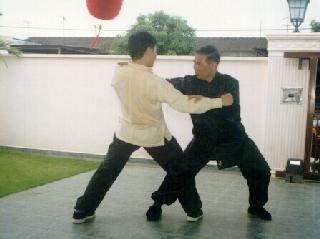
Felling Tree with Roots
Planning a Strategy to Fell an Opponent
For better understanding, all attacks can be divided into four categories, namely striking, kicking, felling and gripping. We have learnt striking and kicking attacks, and their defences. In the following four sequences, we shall learn felling attacks. Some gripping techniques are also introduced.
The following combat principles are important when using felling techniques:
- It is of utmost important to “close” the opponent before applying felling techniques so as not to expose yourself to serious counter attacks.
- Felling an opponent is not a test of brutal strength. Off balance him so that you can fell him easily.
- Make sure that your opponent cannot kick or strike you, especially at your groin, as he falls and after his fall.
- Felling an opponent by itself is normally not decisive in combat. He can rise up and fight again. Thus, you often have to follow with a decisive strike. On the other hand, felling an opponent and holding him in control is a clear indication of your victory without hurting him unnecessarily.

|

|
| Poise Patterns | Black Tiger |
The poise patterns for the attacking mode and the defending mode are also changed. In Combat Sequences 1 to 8 we use “Lohan Asks the Way” as the poise pattern to initiate an attack, and “Single Tiger Emerges from Cave” (right mode) to respond. In Sequences 9 to 12, both the initiator and the responder use “Lohan Asks the Way”. In the present section, Sequences 13 to16, the poise patterns adapted by the initiator and the defender are reversed — the one poising in “Single Tiger Emerges from Cave” initiates, and the one in “Lohan Asks the Way” responds.
In the Combat Sequences constituting the set “Fierce Tiger Descends Mountain” which is practiced at the intermediate level and where gripping techniques using the Tiger-Claws are emphasized, both the initiator and the responder use “Single Tiger Emerges from Cave”. In this way, students become familiar with both the right mode and the left mode for attack and defence.
Both combatants observe each other from their poise patterns. As usual, the initiator opens the attack with “Black Tiger”.
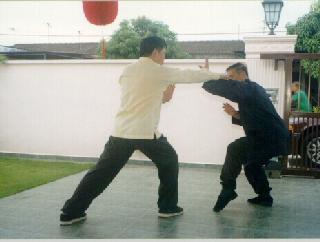
|

|
| Fierce Tiger | Felling Tree |
The responder counter-attacks with “Fierce Tiger”, and if the opponent is incompetent he can follow up with pressing attacks, like in Sequences 5 to 8. You should practice such continuations as variations.
But here the initiator is competent. In fact his initial “Black Tiger” is a “lead”, tempting the opponent to respond with “Fierce Tiger” or any attack using the right mode. It is expected that if the opponent wants to counter-attack, it is likely he will use a right hand attack in a right leg stance, because doing otherwise would be disadvantageous. If he wishes to change to a left Bow-Arrow Stance, for example, he would need a split second to do so, and the initiator can exploit the transitional period.
So, the initiator is ready for the opponent's right thrust punch executed at the right Bow-Arrow Stance. He adjusts his footwork, “threads” the punch, grips the punching arm, moves forward to secure anchorage with his right leg, “closes” the opponent's left hand, off-balances him, and fells him onto the ground. Many movements are needed for this felling technique, but he can do so effectively because he has planned the strategy well. If he has practiced sufficiently and the opponent untrained, the opponent will find himself on the ground without knowing what has happened. By the time he realizes what has happened, he will find a leopard punch on his temple or a tiger-claw at his throat.
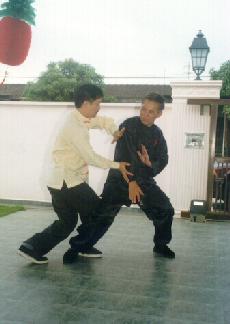
|
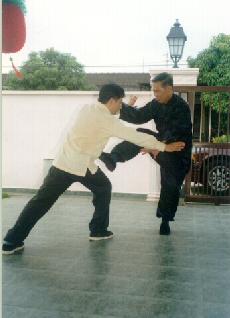
|
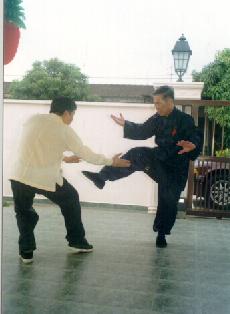
|
| Butterfly Palms | Yellow Bird | Trim Bamboo |
But the responder is also well trained. By changing his footwork from a Bow-Arrow Stance to a Unicorn Step, he neutralizes the felling attack, and follows up by moving his front leg forward with “Butterfly Palms”.
The initiator separates the double-palm attack and counters with a organ-seeking kick. The responder retreats his front leg in a False-Leg Stance and strikes the kicking leg with “Trim Bamboo together with Branches”, using the tactic of “no defence direct counter”.

|

|
| Angry Leopard | Poise Patterns |
The initiator quickly withdraws his leg, “tames” the opponent's front hand, and moves forward to a right Bow-Arrow Stance to attack with a leopard punch, using the pattern “Angry Leopard Charges at Fire”. It is important to “tame” the opponent's hand, otherwise he would jab a palm strike to the initiator's ribs or stomach.
Seeing that the responder could neutralize his series of attacks effectively, the initiator withdraws his front leg back into a right False-Leg Stance using the poise pattern “Single Tiger Emerges from Cave” to observe the opponent. This is a wise move. When your opponent can neutralize your series of planned attacks, it is advisable to withdraw a step to assess the situation again, instead of continuing to attack and may therefore expose yourself to risky counter attacks.
If the responder wishes to reverse the initiative, this is a good opportunity to do so. Before the initiator could withdraw, the responder can continue with any of the Sequences 1 to 12. You should practice such continuations on your own.
OVERVIEW

|

|
| Poise Pattern | Black Tiger |

|

|
| Fierce Tiger | Felling Tree |

|

|

|
| Butterfly Palms | Yellow Bird | Trim Bamboo |

|

|
| Angry Leopard | Poise Patterns |
LINKS
Other Combat Sequences
Hand Attacks- Combat Sequence 1: Black Tiger Steals Heart — Pictures
- Combat Sequence 2: White Snake Shoots Venom — Pictures
- Combat Sequence 3: Precious Duck Swims Through Lotus — Pictures
- Combat Sequence 4: Hang a Golden Star at a Corner — Pictures
- Combat Sequence 5: Fierce Tiger Speeds Through Valley — Pictures
- Combat Sequence 6: Dark Dragon Draws Water — Pictures
- Combat Sequence 7: Chop the Hua Mountain — Pictures
- Combat Sequence 8: Horizontally Sweep a Thousand Armies — Pictures
Leg Attacks
- Combat Sequence 9: Happy Bird Hops up Branch — Pictures
- Combat Sequence 10: White Horse Presents Hoof — Pictures
- Combat Sequence 11: Yellow Bird Plays with Water — Pictures
- Combat Sequence 12: Naughty Monkey Kicks at Tree — Pictures
Felling and Gripping Attacks
- Combat Sequence 13: Fell Tree with Roots — Pictures
- Combat Sequence 14: Lead Horse Back to Stable — Pictures
- Combat Sequence 15: Farmer Hoes Rice Field — Pictures
- Combat Sequence 16: Fierce Tiger Pushes Mountains — Pictures
